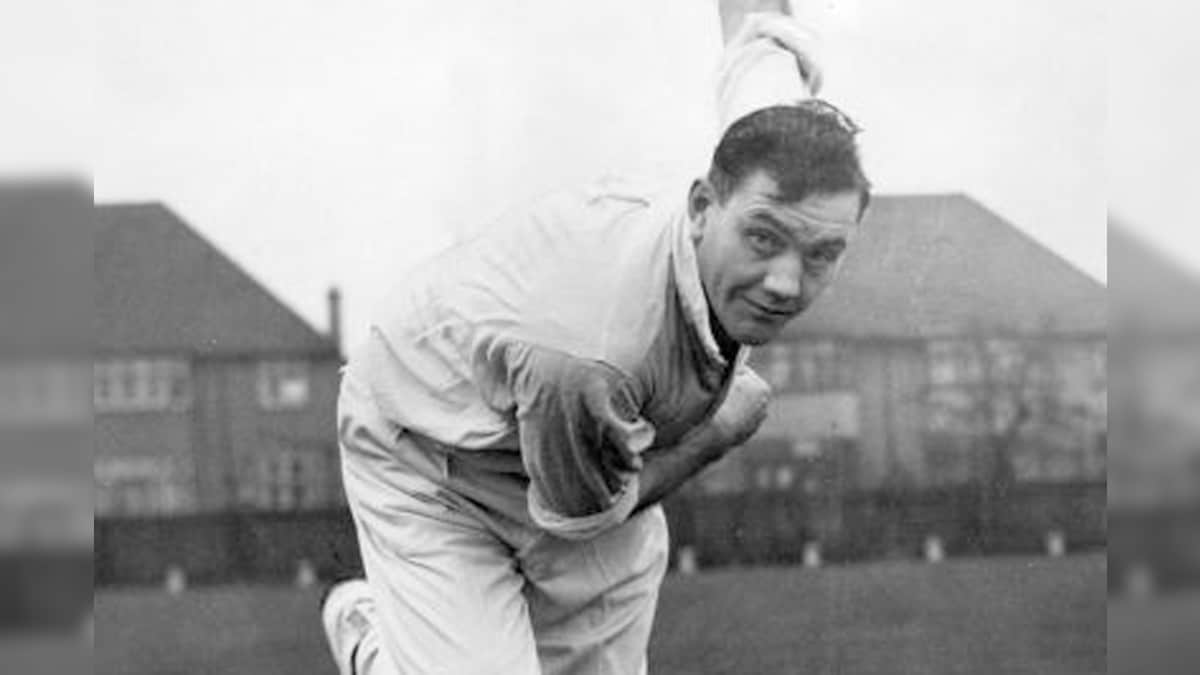In post-World War Two England, Alec Bedser embodied cricket’s restorative power, his resurgent bowling spearheading national recovery on the pitch while buoying public morale. Surrey origins honed his craft before 165 wickets across 51 Tests cemented a reputation for perseverance and punishing stamina.
At the crease, Bedser churned out high-velocity spells unraveling the order with steep bounce and brisk pace that never relented. His very syllables induced trauma in batsmen bracing for hourly barrages targeting the stumps and shoulders. Such resilience powered phenomenal feats like 55 wickets touring Australia and 10-wicket Test hauls.
Article Highlights
Hide- Alec Bedser was born on July 4, 1918, in Reading, Berkshire, and developed a passion for cricket at a young age.
- He honed his skills as a medium-fast bowler and caught the attention of Surrey County Cricket Club, emerging as a formidable seam bowler known for his accuracy and ability to swing the ball.
- Bedser achieved several key career milestones, including his Test debut for England in 1946, capturing 236 Test wickets (an English record at the time), and being integral to England's Ashes victory in 1953.
- His mastery of seam bowling inspired precision and technique, influenced subsequent generations of seam bowlers, and continues to be celebrated in cricket history as one of the greatest seam bowlers of all time.
Bedser’s true legacy however lies through his cultural imprint. As Wally Hammond’s successor, Bedser shepherded a rising generation, mentoring figures who dominated coming decades.
His very presence offered hope to a war-wearied nation seeking uplifting icons. Both as relentless wicket-taker and selfless role model, Alec Bedser represented England’s greater post-war journey back to prosperity.
Early Life and Background
Alec Bedser was born on July 4, 1918, in Reading, Berkshire, into a working-class family, where he and his identical twin brother, Eric, developed a passion for cricket at a young age.
The domestic environment of the Bedser family, coupled with the socio-economic milieu of the inter-war period, likely provided a backdrop that emphasized the virtues of discipline and perseverance. These characteristics would later become hallmarks of Alec Bedser’s approach to the sport.
Jeff Thomson
In the 1970s and early 80s, Jeff Thomson unleashed blistering pace spells that terrorized global ... Read More
Bedser’s formative years in cricket involved playing extensively for local teams, where he honed his skills as a medium-fast bowler. His early exposure to cricket in a competitive environment fostered a robust understanding of the game’s nuances, which was reflected in his meticulous bowling technique.
The Bedser twins were notably influential in each other’s development, with their fraternal competition serving as a catalyst for improvement.
Analyzing Bedser’s early life, one can deduce that his working-class roots may have instilled in him a strong work ethic, which was essential in the era before cricket became fully professionalized.
This foundation was critical in shaping his cricketing ethos and his eventual ascent into the professional realm. Bedser’s early experiences laid the groundwork for a career that would be marked by technical proficiency and a relentless pursuit of cricketing excellence.
Alec Bedser: Rise in English Cricket
Building upon his foundational years in local cricket, Bedser’s prowess with the ball soon caught the attention of Surrey County Cricket Club, setting the stage for his ascension in English cricket.
Alec Bedser’s induction into Surrey in the late 1930s marked the emergence of a formidable seam bowler who would come to dominate the English bowling scene for years to come.
His ability to combine pace with unerring accuracy and subtle variations in swing rendered him an invaluable asset to his county side.
In a detailed analysis of Bedser’s early statistical contributions to Surrey, one observes a marked consistency and a propensity for taking wickets in challenging conditions.
This period was punctuated by interruptions due to the Second World War, yet Bedser’s dedication to refining his craft was undiminished. Post-war, his domestic form surged, catalyzing his selection to the national side.
Bedser’s international debut in 1946 against India showcased his mastery over line and length, and the intricacies of seam movement on English pitches.
His rise was not merely a function of his skill but also an embodiment of post-war English cricket’s ethos: resilience, precision, and an unwavering commitment to excellence.
Key Career Milestones
Charting a trajectory of remarkable achievements, Bedser’s career milestones reflect his status as one of cricket’s most esteemed seam bowlers.
His career was punctuated by a series of significant accomplishments that not only defined his playing years but also left an indelible mark on the sport.
The analytical dissection of his key milestones presents an enlightening perspective on his profound impact within the cricketing fraternity.
To engage the audience and provide a clear visual representation, here is a table outlining some of Bedser’s career highlights:
| Year | Milestone | Significance |
|---|---|---|
| 1939 | First-class Debut | Initiation into professional cricket with Surrey |
| 1946 | Test Debut for England | Commencement of international career post-WWII |
| 1950 | 100 Test Wickets | Achieved this feat in just 21 matches |
| 1953 | Ashes Victory | Integral to England regaining the Ashes |
| 1960 | Retirement | Concluded an illustrious playing career |
Each entry in this table represents a critical juncture in Bedser’s progression as a cricketer, from his entry into first-class cricket to the culmination of his professional journey.
The statistical and historical significance embedded within these milestones substantiates Bedser’s mastery of seam bowling and his role in shaping the golden era of English cricket.
Alec Bedser: Statistical Highlights
Moving beyond the timeline of Alec Bedser’s career, a closer examination of his statistical achievements provides a quantifiable testament to his prowess as a seam bowler.
His contributions to the game are not merely anecdotal; they are deeply rooted in a substantial statistical legacy that reflects both his skill and endurance in the sport. To comprehend the breadth of Bedser’s impact, one must consider the following key figures:
- 236 – The number of Test wickets he captured over his career, which at the time of his retirement was an English record.
- 51.1 – His astonishing bowling average in first-class cricket, evidencing his consistent ability to dismiss batsmen.
- 27.49 – Bedser’s Test bowling average, a figure that underscores his effectiveness at the highest level of the game.
- 5 – The number of times he took 10 wickets in a match in Test cricket, illustrating his capacity to dominate an entire game.
These numbers, while stark, only scratch the surface of Bedser’s statistical footprint. An analytical dive into his career must account for the era’s playing conditions, the quality of opposition, and the cricketing equipment of the time, to fully appreciate the magnitude of his achievements.
Bedser’s statistical records, therefore, not only chronicle his individual triumphs but also serve as a barometer of his era’s cricketing standards.
Legacy and Influence
Alec Bedser’s enduring legacy in cricket extends far beyond his impressive statistics, influencing subsequent generations of seam bowlers and shaping the sport’s tactical evolution.
His nuanced understanding of seam bowling mechanics and strategic acumen imparted a blueprint for aspiring cricketers. Bedser’s methodical approach to the game underscored the importance of skillful swing and seam manipulation, setting a benchmark for future bowlers who sought to master the art.
The table below illustrates key aspects of Bedser’s influence on cricket:
| Aspect | Influence on Cricket |
|---|---|
| Mastery of Seam Bowling | Inspired bowlers to prioritize precision and technique |
| Tactical Prowess | Encouraged a cerebral approach to bowling strategies |
Bedser’s influence is not confined to the technical realm but also includes his contributions to cricketing tactics. His ability to exploit pitch conditions and assess batsmen’s weaknesses instilled a more thoughtful and analytical approach to the game.
This strategic depth enhanced the role of bowlers in planning and executing match-winning plays. As cricket continues to evolve, the analytical and detailed study of Bedser’s career remains a valuable resource for players and coaches alike, seeking to refine their craft and adapt to the sophisticated demands of the sport. His legacy, therefore, is not just in records but in the perpetuation of a cerebral and skillful approach to seam bowling.
Summary
In conclusion, Sir Alec Bedser’s distinguished career in English cricket is marked by notable achievements and a profound impact on the sport.
His statistical records reflect a remarkable talent and dedication to cricket, while his legacy endures through his influence on future generations of cricketers.
Bedser’s contributions to the game have been recognized both during his lifetime and posthumously, solidifying his place as one of cricket’s most enduring figures.

















